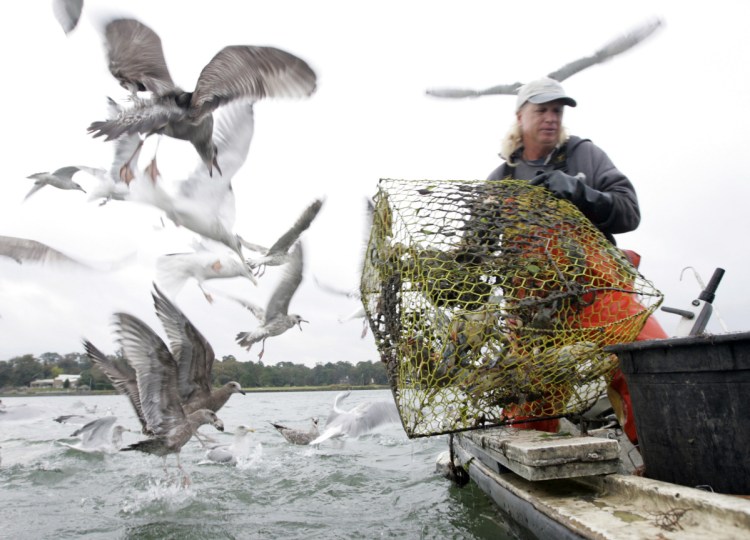For the first time in the 33 years that scientists have assessed the health of the Chesapeake Bay, the nation’s largest estuary showed improvement in every region, a likely sign that a massive federal cleanup plan is working.
The bay’s most important species – blue crabs and striped bass, which support commercial and recreational fisheries, and anchovies, the foundation of its food chain – earned top scores in a report card released Friday. Bright green underwater grasses – which help protect young fish before they venture into the Atlantic Ocean – are now thriving, even in some places where such vegetation had disappeared.
In sharp contrast to the days when the bay was so beleaguered that every meaningful species experienced sharp population declines, officials and scientists from the District, Maryland and Virginia are set to announce Friday morning that it is in the midst of a full and remarkable recovery.
The news comes at a time when hundreds of bottle-nosed dolphins have been seen frolicking in its watershed, including a large pod off Maryland’s Ragged Point last month. On Tuesday, two great white sharks were hooked by scientists in Virginia. The number of fish-hunting osprey is on the rise.
DEAD ZONES DECREASE
The bay’s overall grade is a C because some areas, such as the Patuxent, Patapsco and York rivers, are bouncing back from near failure. The category of water clarity faltered, falling to an F from last year’s D. But the James River area and the lower stem of the bay closer to the Atlantic both earned grades of at least B-, their highest ever, and shored up the overall score.
“We have seen individual regions improving before, but not the entire Chesapeake Bay,” said Bill Dennison, vice president for science application at the University of Maryland Center for Environmental Science. “It seems that the restoration efforts are beginning to take hold.”
Seven out of the 15 regions, including Patapsco and Back rivers (with Baltimore), show significantly improving health. The Potomac River region, which includes part of the District, is holding steady.
“The long-term trend is statistically, significantly improving over time,” said Alexandra Fries, a senior science communicator at the center. “There are no regions in decline.”
The 15-year, $19 billion cleanup plan is administered by the Environmental Protection Agency and holds the six states in the Chesapeake watershed to specific pollution limits. Under the plan, which President Barack Obama mandated in 2010 through an executive order, Virginia, Maryland, Delaware, West Virginia, Pennsylvania and New York, along with the District, agreed to substantially improve wastewater treatment facilities and decrease runoff from farms once responsible for significant amounts of waste reaching the rivers and streams that run into the bay.
Studies have shown that cutting such pollution – nitrogen and phosphorous from human activities, as well as sediment from dusty building sites – has reduced the size and number of “dead zones” where fish, oysters and other creatures die in oxygen-depleted water.
Marine scientists created the bay’s report card 12 years ago to explain the complicated statistical data they collect. In 2011, the year with the worst marks, a dead zone extended from the Baltimore Harbor to the bay’s midchannel region in the Potomac River. That covered 83 miles, or a third of the bay.
The environmental science center recently released a report showing that decreasing nutrient loads from farms and urban treatment plants are causing dead zones to break up earlier in the summer, the season when they thrive.
“It’s very much related to the improvements we’re starting to see in the bay health overall,” Dennison said, “yet another sign that things are improving on a baywide level and that’s really a powerful story.”
Scientists credit the cleanup plan for fueling the turnaround. Although President Trump tried to eliminate the plan’s funding in his fiscal 2018 budget proposal and cut it by 90 percent for fiscal 2019, congressional support for the restoration effort remains strong.
DON’T RELAX YET, THOUGH
Still, as rosy as the latest news seems, Maryland’s environment secretary urges restraint. “Our investments and actions are making a difference, so we need to keep up the bipartisan momentum now more than ever,” Ben Grumbles said Wednesday.
Grumbles noted that big challenges remain, including his state’s effort to address the enormous sediment buildup behind the Conowingo Hydroelectric Dam that sits on the Susquehanna River at Maryland’s border with Pennsylvania.
According to a report issued last year by the EPA’s Chesapeake Bay Program, a reservoir behind the dam has filled with sediment far sooner than the EPA anticipated. Its ability to hold back that sediment, which scours bay grasses and degrades their life-sustaining capabilities, was a major factor in the cleanup plan’s success.
The reservoir is 95 percent full and could stop protecting the bay in the next three years, the report concluded, not the 2030-2035 timeline the agency had projected.
Copy the Story LinkSend questions/comments to the editors.



Success. Please wait for the page to reload. If the page does not reload within 5 seconds, please refresh the page.
Enter your email and password to access comments.
Hi, to comment on stories you must . This profile is in addition to your subscription and website login.
Already have a commenting profile? .
Invalid username/password.
Please check your email to confirm and complete your registration.
Only subscribers are eligible to post comments. Please subscribe or login first for digital access. Here’s why.
Use the form below to reset your password. When you've submitted your account email, we will send an email with a reset code.